Strategic Management and Leadership Skills Report: University Analysis
VerifiedAdded on 2019/10/31
|7
|1472
|117
Report
AI Summary
This report delves into the realm of strategic management and leadership, exploring the application of psychological type theory, specifically focusing on the ESFJ personality type. The report begins by outlining the core concepts of Carl Jung's theory of psychological types, including extraversion/introversion, sensing/intuition, and thinking/feeling dichotomies. It then describes the ESFJ personality type (Extravert, Sensing, Feeling, and Judging), detailing the characteristics of this common type, such as sociability, practicality, and a focus on harmony and tradition. The author provides a self-assessment, reflecting on how their personality aligns with the ESFJ profile, highlighting strengths like loyalty and a sense of responsibility. The report also discusses the reliability of personality tests like the Myers-Briggs Type Indicator (MBTI), and the potential benefits of using the 'Big Five' personality traits for a more comprehensive understanding of individual personalities. The report concludes by acknowledging personal challenges and emphasizing the importance of self-awareness and adapting to different viewpoints within a leadership context.
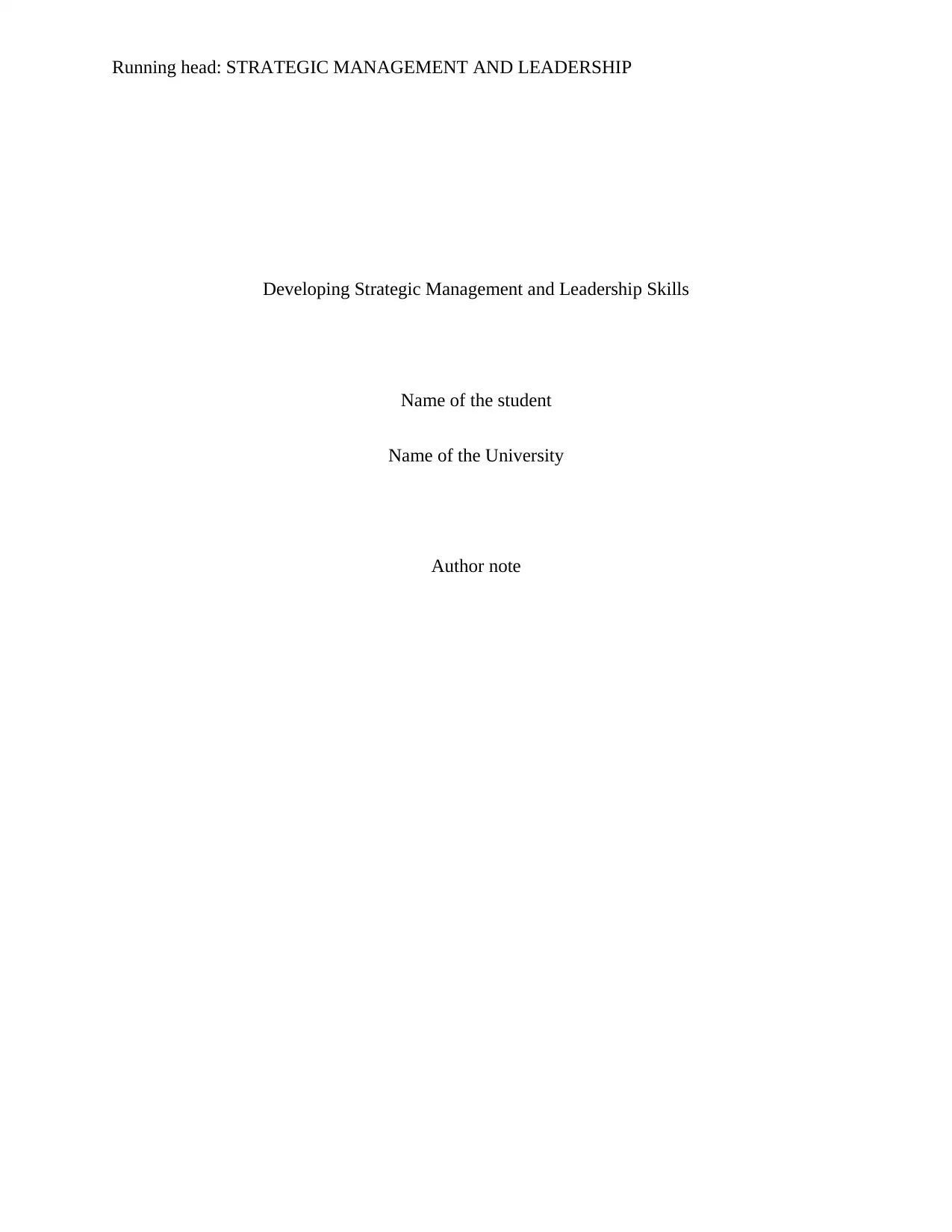
Running head: STRATEGIC MANAGEMENT AND LEADERSHIP
Developing Strategic Management and Leadership Skills
Name of the student
Name of the University
Author note
Developing Strategic Management and Leadership Skills
Name of the student
Name of the University
Author note
Paraphrase This Document
Need a fresh take? Get an instant paraphrase of this document with our AI Paraphraser
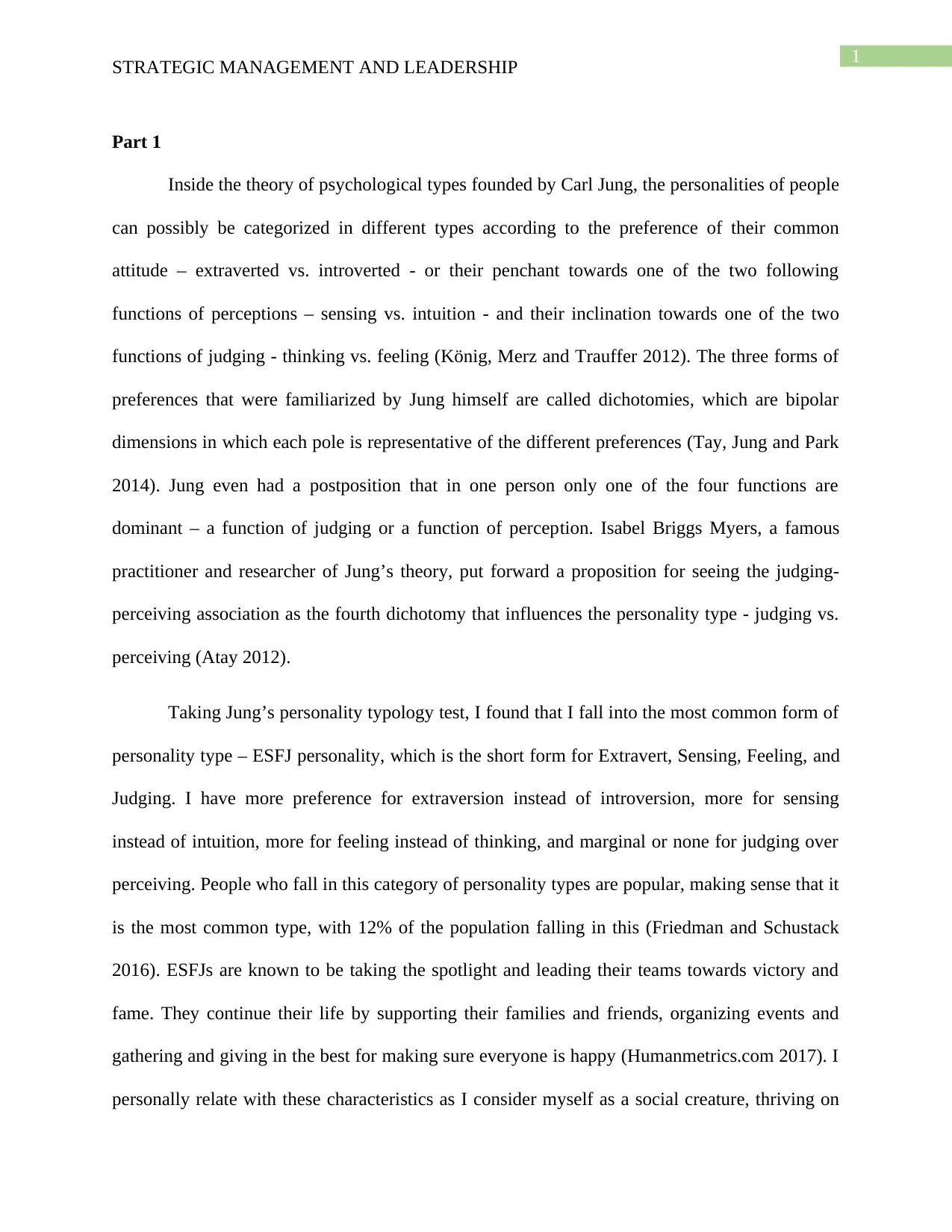
1
STRATEGIC MANAGEMENT AND LEADERSHIP
Part 1
Inside the theory of psychological types founded by Carl Jung, the personalities of people
can possibly be categorized in different types according to the preference of their common
attitude – extraverted vs. introverted - or their penchant towards one of the two following
functions of perceptions – sensing vs. intuition - and their inclination towards one of the two
functions of judging - thinking vs. feeling (König, Merz and Trauffer 2012). The three forms of
preferences that were familiarized by Jung himself are called dichotomies, which are bipolar
dimensions in which each pole is representative of the different preferences (Tay, Jung and Park
2014). Jung even had a postposition that in one person only one of the four functions are
dominant – a function of judging or a function of perception. Isabel Briggs Myers, a famous
practitioner and researcher of Jung’s theory, put forward a proposition for seeing the judging-
perceiving association as the fourth dichotomy that influences the personality type - judging vs.
perceiving (Atay 2012).
Taking Jung’s personality typology test, I found that I fall into the most common form of
personality type – ESFJ personality, which is the short form for Extravert, Sensing, Feeling, and
Judging. I have more preference for extraversion instead of introversion, more for sensing
instead of intuition, more for feeling instead of thinking, and marginal or none for judging over
perceiving. People who fall in this category of personality types are popular, making sense that it
is the most common type, with 12% of the population falling in this (Friedman and Schustack
2016). ESFJs are known to be taking the spotlight and leading their teams towards victory and
fame. They continue their life by supporting their families and friends, organizing events and
gathering and giving in the best for making sure everyone is happy (Humanmetrics.com 2017). I
personally relate with these characteristics as I consider myself as a social creature, thriving on
STRATEGIC MANAGEMENT AND LEADERSHIP
Part 1
Inside the theory of psychological types founded by Carl Jung, the personalities of people
can possibly be categorized in different types according to the preference of their common
attitude – extraverted vs. introverted - or their penchant towards one of the two following
functions of perceptions – sensing vs. intuition - and their inclination towards one of the two
functions of judging - thinking vs. feeling (König, Merz and Trauffer 2012). The three forms of
preferences that were familiarized by Jung himself are called dichotomies, which are bipolar
dimensions in which each pole is representative of the different preferences (Tay, Jung and Park
2014). Jung even had a postposition that in one person only one of the four functions are
dominant – a function of judging or a function of perception. Isabel Briggs Myers, a famous
practitioner and researcher of Jung’s theory, put forward a proposition for seeing the judging-
perceiving association as the fourth dichotomy that influences the personality type - judging vs.
perceiving (Atay 2012).
Taking Jung’s personality typology test, I found that I fall into the most common form of
personality type – ESFJ personality, which is the short form for Extravert, Sensing, Feeling, and
Judging. I have more preference for extraversion instead of introversion, more for sensing
instead of intuition, more for feeling instead of thinking, and marginal or none for judging over
perceiving. People who fall in this category of personality types are popular, making sense that it
is the most common type, with 12% of the population falling in this (Friedman and Schustack
2016). ESFJs are known to be taking the spotlight and leading their teams towards victory and
fame. They continue their life by supporting their families and friends, organizing events and
gathering and giving in the best for making sure everyone is happy (Humanmetrics.com 2017). I
personally relate with these characteristics as I consider myself as a social creature, thriving on
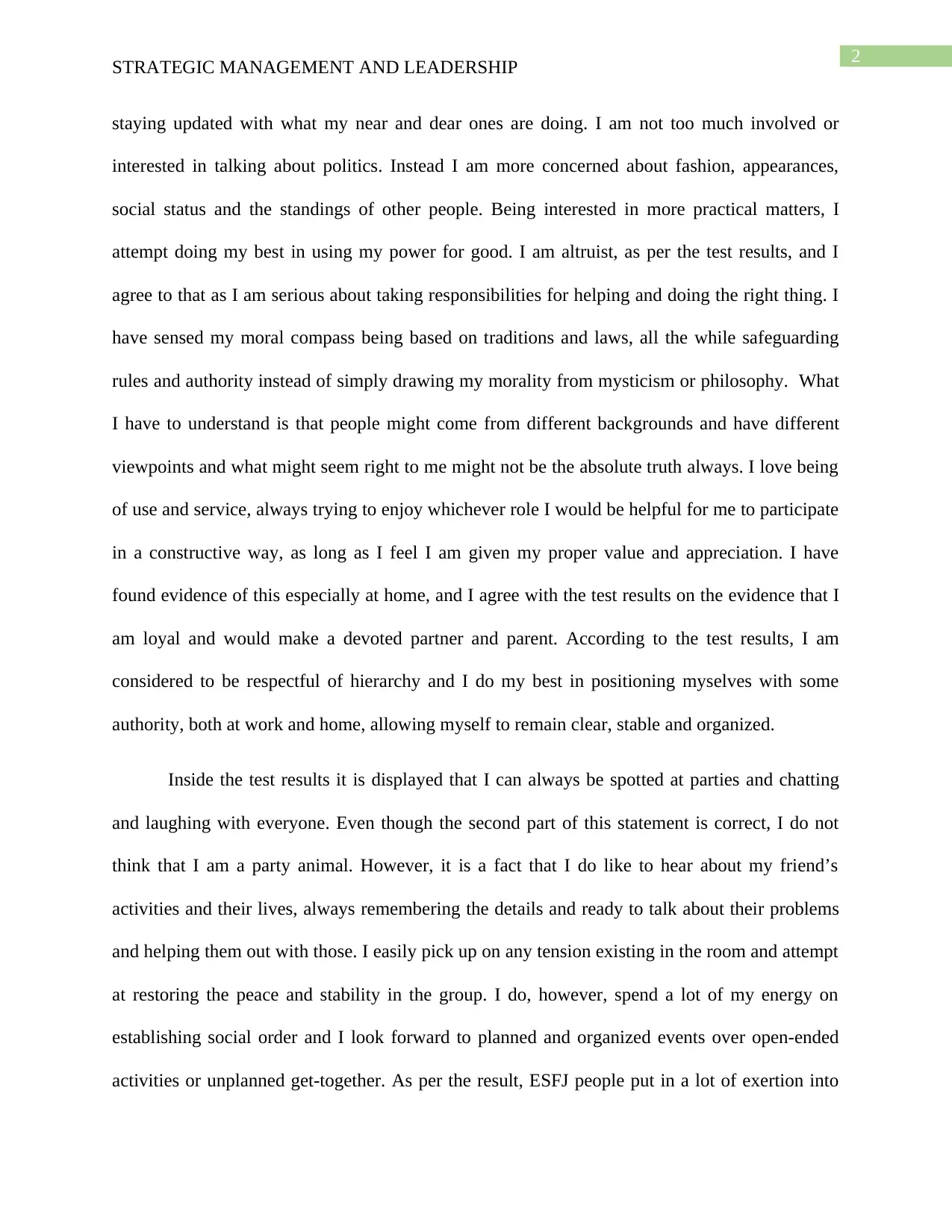
2
STRATEGIC MANAGEMENT AND LEADERSHIP
staying updated with what my near and dear ones are doing. I am not too much involved or
interested in talking about politics. Instead I am more concerned about fashion, appearances,
social status and the standings of other people. Being interested in more practical matters, I
attempt doing my best in using my power for good. I am altruist, as per the test results, and I
agree to that as I am serious about taking responsibilities for helping and doing the right thing. I
have sensed my moral compass being based on traditions and laws, all the while safeguarding
rules and authority instead of simply drawing my morality from mysticism or philosophy. What
I have to understand is that people might come from different backgrounds and have different
viewpoints and what might seem right to me might not be the absolute truth always. I love being
of use and service, always trying to enjoy whichever role I would be helpful for me to participate
in a constructive way, as long as I feel I am given my proper value and appreciation. I have
found evidence of this especially at home, and I agree with the test results on the evidence that I
am loyal and would make a devoted partner and parent. According to the test results, I am
considered to be respectful of hierarchy and I do my best in positioning myselves with some
authority, both at work and home, allowing myself to remain clear, stable and organized.
Inside the test results it is displayed that I can always be spotted at parties and chatting
and laughing with everyone. Even though the second part of this statement is correct, I do not
think that I am a party animal. However, it is a fact that I do like to hear about my friend’s
activities and their lives, always remembering the details and ready to talk about their problems
and helping them out with those. I easily pick up on any tension existing in the room and attempt
at restoring the peace and stability in the group. I do, however, spend a lot of my energy on
establishing social order and I look forward to planned and organized events over open-ended
activities or unplanned get-together. As per the result, ESFJ people put in a lot of exertion into
STRATEGIC MANAGEMENT AND LEADERSHIP
staying updated with what my near and dear ones are doing. I am not too much involved or
interested in talking about politics. Instead I am more concerned about fashion, appearances,
social status and the standings of other people. Being interested in more practical matters, I
attempt doing my best in using my power for good. I am altruist, as per the test results, and I
agree to that as I am serious about taking responsibilities for helping and doing the right thing. I
have sensed my moral compass being based on traditions and laws, all the while safeguarding
rules and authority instead of simply drawing my morality from mysticism or philosophy. What
I have to understand is that people might come from different backgrounds and have different
viewpoints and what might seem right to me might not be the absolute truth always. I love being
of use and service, always trying to enjoy whichever role I would be helpful for me to participate
in a constructive way, as long as I feel I am given my proper value and appreciation. I have
found evidence of this especially at home, and I agree with the test results on the evidence that I
am loyal and would make a devoted partner and parent. According to the test results, I am
considered to be respectful of hierarchy and I do my best in positioning myselves with some
authority, both at work and home, allowing myself to remain clear, stable and organized.
Inside the test results it is displayed that I can always be spotted at parties and chatting
and laughing with everyone. Even though the second part of this statement is correct, I do not
think that I am a party animal. However, it is a fact that I do like to hear about my friend’s
activities and their lives, always remembering the details and ready to talk about their problems
and helping them out with those. I easily pick up on any tension existing in the room and attempt
at restoring the peace and stability in the group. I do, however, spend a lot of my energy on
establishing social order and I look forward to planned and organized events over open-ended
activities or unplanned get-together. As per the result, ESFJ people put in a lot of exertion into
⊘ This is a preview!⊘
Do you want full access?
Subscribe today to unlock all pages.

Trusted by 1+ million students worldwide
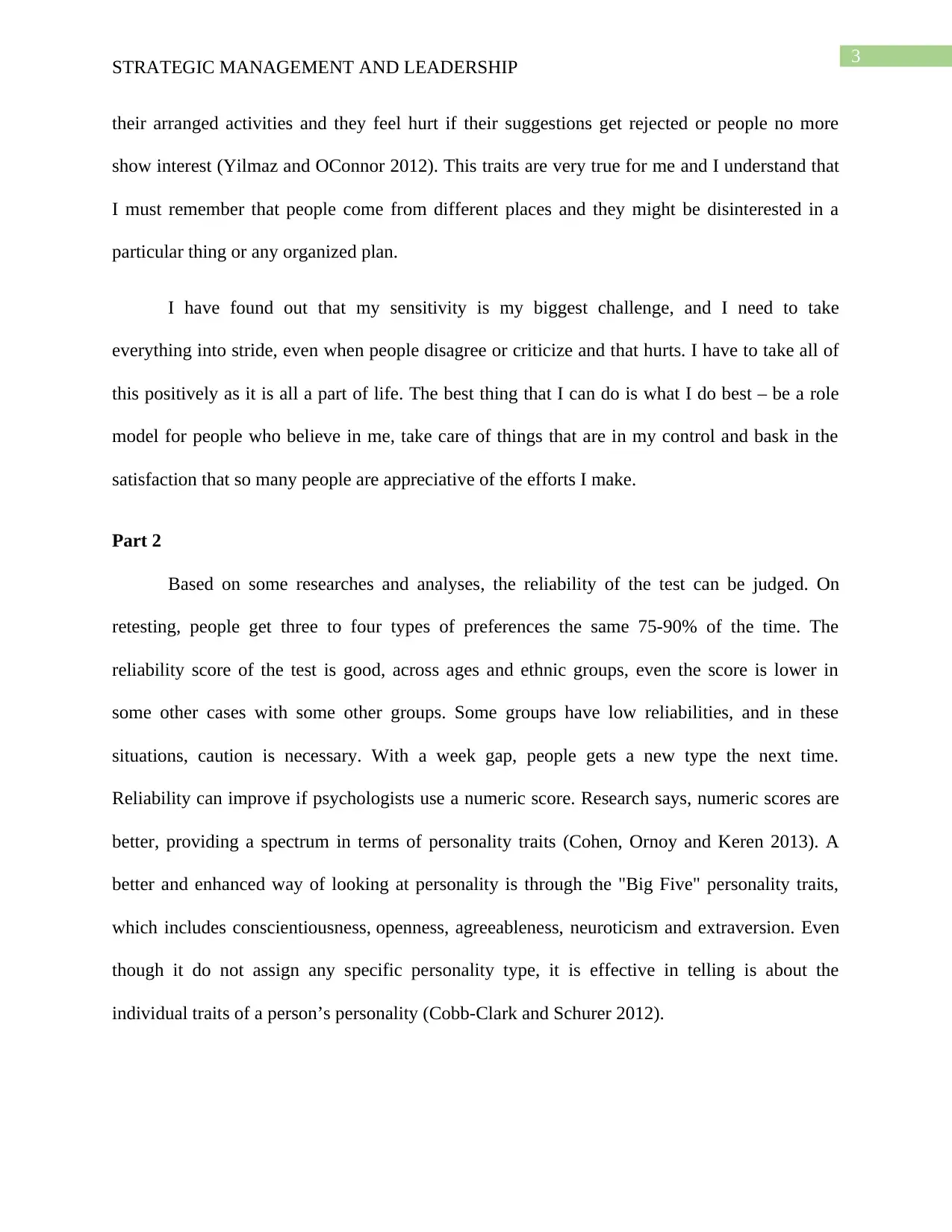
3
STRATEGIC MANAGEMENT AND LEADERSHIP
their arranged activities and they feel hurt if their suggestions get rejected or people no more
show interest (Yilmaz and OConnor 2012). This traits are very true for me and I understand that
I must remember that people come from different places and they might be disinterested in a
particular thing or any organized plan.
I have found out that my sensitivity is my biggest challenge, and I need to take
everything into stride, even when people disagree or criticize and that hurts. I have to take all of
this positively as it is all a part of life. The best thing that I can do is what I do best – be a role
model for people who believe in me, take care of things that are in my control and bask in the
satisfaction that so many people are appreciative of the efforts I make.
Part 2
Based on some researches and analyses, the reliability of the test can be judged. On
retesting, people get three to four types of preferences the same 75-90% of the time. The
reliability score of the test is good, across ages and ethnic groups, even the score is lower in
some other cases with some other groups. Some groups have low reliabilities, and in these
situations, caution is necessary. With a week gap, people gets a new type the next time.
Reliability can improve if psychologists use a numeric score. Research says, numeric scores are
better, providing a spectrum in terms of personality traits (Cohen, Ornoy and Keren 2013). A
better and enhanced way of looking at personality is through the "Big Five" personality traits,
which includes conscientiousness, openness, agreeableness, neuroticism and extraversion. Even
though it do not assign any specific personality type, it is effective in telling is about the
individual traits of a person’s personality (Cobb-Clark and Schurer 2012).
STRATEGIC MANAGEMENT AND LEADERSHIP
their arranged activities and they feel hurt if their suggestions get rejected or people no more
show interest (Yilmaz and OConnor 2012). This traits are very true for me and I understand that
I must remember that people come from different places and they might be disinterested in a
particular thing or any organized plan.
I have found out that my sensitivity is my biggest challenge, and I need to take
everything into stride, even when people disagree or criticize and that hurts. I have to take all of
this positively as it is all a part of life. The best thing that I can do is what I do best – be a role
model for people who believe in me, take care of things that are in my control and bask in the
satisfaction that so many people are appreciative of the efforts I make.
Part 2
Based on some researches and analyses, the reliability of the test can be judged. On
retesting, people get three to four types of preferences the same 75-90% of the time. The
reliability score of the test is good, across ages and ethnic groups, even the score is lower in
some other cases with some other groups. Some groups have low reliabilities, and in these
situations, caution is necessary. With a week gap, people gets a new type the next time.
Reliability can improve if psychologists use a numeric score. Research says, numeric scores are
better, providing a spectrum in terms of personality traits (Cohen, Ornoy and Keren 2013). A
better and enhanced way of looking at personality is through the "Big Five" personality traits,
which includes conscientiousness, openness, agreeableness, neuroticism and extraversion. Even
though it do not assign any specific personality type, it is effective in telling is about the
individual traits of a person’s personality (Cobb-Clark and Schurer 2012).
Paraphrase This Document
Need a fresh take? Get an instant paraphrase of this document with our AI Paraphraser
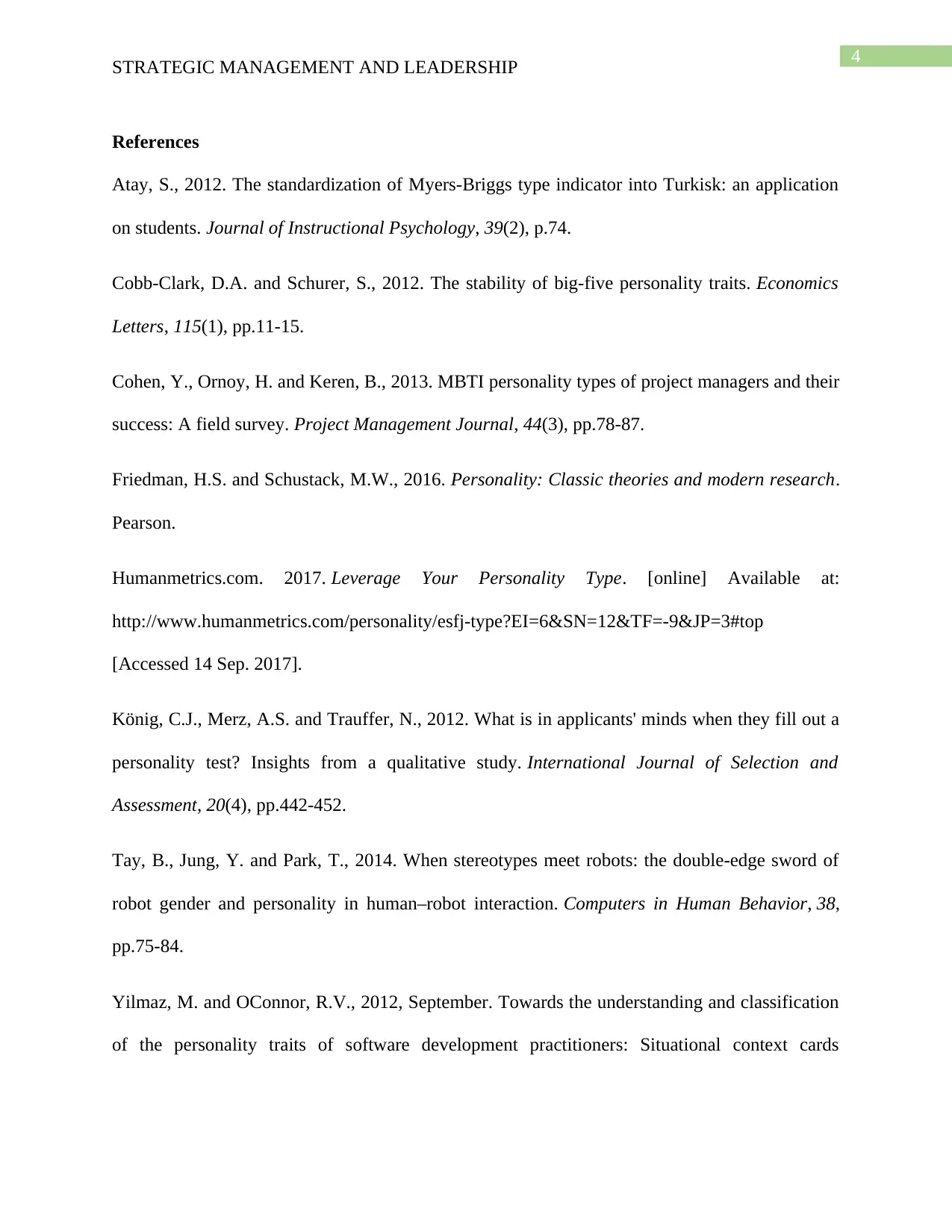
4
STRATEGIC MANAGEMENT AND LEADERSHIP
References
Atay, S., 2012. The standardization of Myers-Briggs type indicator into Turkisk: an application
on students. Journal of Instructional Psychology, 39(2), p.74.
Cobb-Clark, D.A. and Schurer, S., 2012. The stability of big-five personality traits. Economics
Letters, 115(1), pp.11-15.
Cohen, Y., Ornoy, H. and Keren, B., 2013. MBTI personality types of project managers and their
success: A field survey. Project Management Journal, 44(3), pp.78-87.
Friedman, H.S. and Schustack, M.W., 2016. Personality: Classic theories and modern research.
Pearson.
Humanmetrics.com. 2017. Leverage Your Personality Type. [online] Available at:
http://www.humanmetrics.com/personality/esfj-type?EI=6&SN=12&TF=-9&JP=3#top
[Accessed 14 Sep. 2017].
König, C.J., Merz, A.S. and Trauffer, N., 2012. What is in applicants' minds when they fill out a
personality test? Insights from a qualitative study. International Journal of Selection and
Assessment, 20(4), pp.442-452.
Tay, B., Jung, Y. and Park, T., 2014. When stereotypes meet robots: the double-edge sword of
robot gender and personality in human–robot interaction. Computers in Human Behavior, 38,
pp.75-84.
Yilmaz, M. and OConnor, R.V., 2012, September. Towards the understanding and classification
of the personality traits of software development practitioners: Situational context cards
STRATEGIC MANAGEMENT AND LEADERSHIP
References
Atay, S., 2012. The standardization of Myers-Briggs type indicator into Turkisk: an application
on students. Journal of Instructional Psychology, 39(2), p.74.
Cobb-Clark, D.A. and Schurer, S., 2012. The stability of big-five personality traits. Economics
Letters, 115(1), pp.11-15.
Cohen, Y., Ornoy, H. and Keren, B., 2013. MBTI personality types of project managers and their
success: A field survey. Project Management Journal, 44(3), pp.78-87.
Friedman, H.S. and Schustack, M.W., 2016. Personality: Classic theories and modern research.
Pearson.
Humanmetrics.com. 2017. Leverage Your Personality Type. [online] Available at:
http://www.humanmetrics.com/personality/esfj-type?EI=6&SN=12&TF=-9&JP=3#top
[Accessed 14 Sep. 2017].
König, C.J., Merz, A.S. and Trauffer, N., 2012. What is in applicants' minds when they fill out a
personality test? Insights from a qualitative study. International Journal of Selection and
Assessment, 20(4), pp.442-452.
Tay, B., Jung, Y. and Park, T., 2014. When stereotypes meet robots: the double-edge sword of
robot gender and personality in human–robot interaction. Computers in Human Behavior, 38,
pp.75-84.
Yilmaz, M. and OConnor, R.V., 2012, September. Towards the understanding and classification
of the personality traits of software development practitioners: Situational context cards
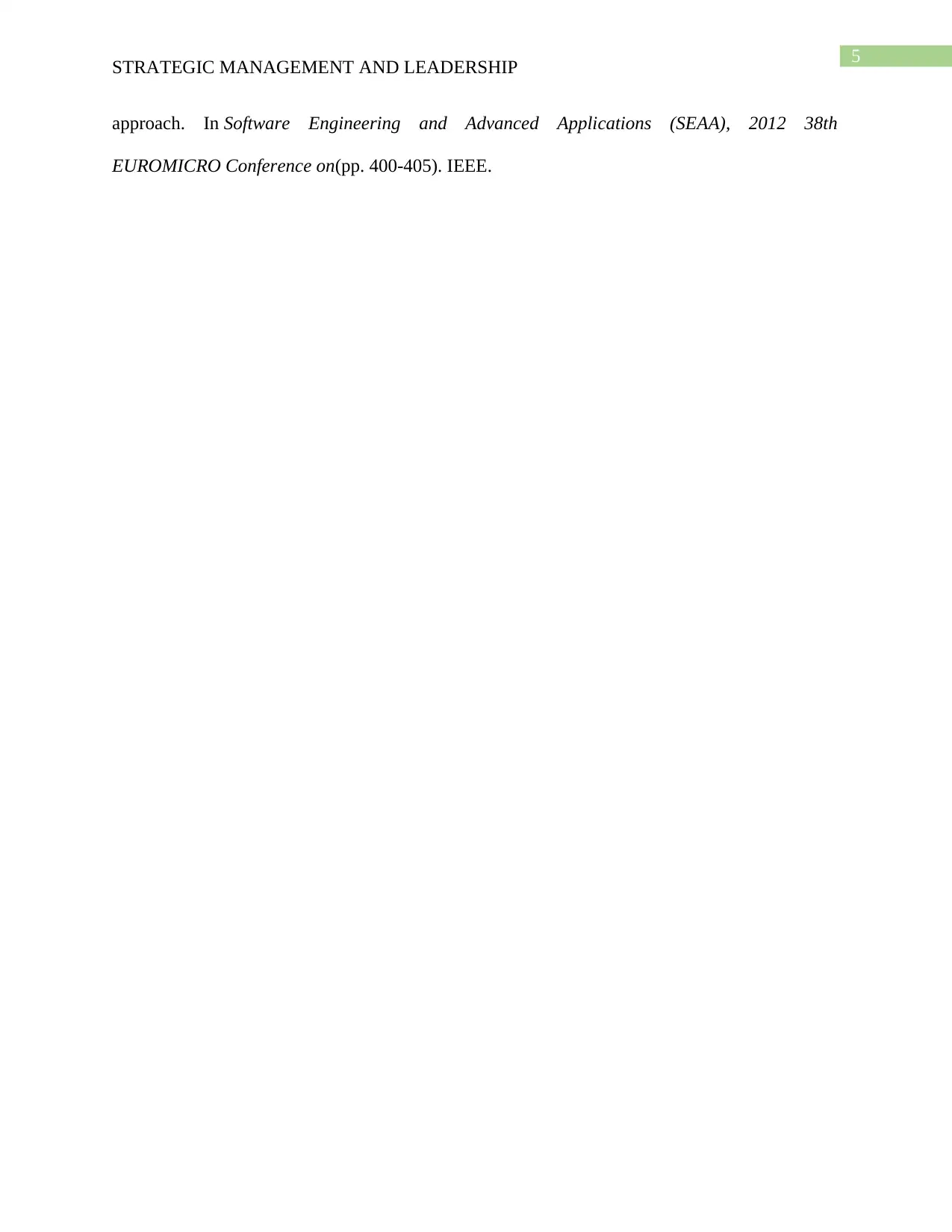
5
STRATEGIC MANAGEMENT AND LEADERSHIP
approach. In Software Engineering and Advanced Applications (SEAA), 2012 38th
EUROMICRO Conference on(pp. 400-405). IEEE.
STRATEGIC MANAGEMENT AND LEADERSHIP
approach. In Software Engineering and Advanced Applications (SEAA), 2012 38th
EUROMICRO Conference on(pp. 400-405). IEEE.
⊘ This is a preview!⊘
Do you want full access?
Subscribe today to unlock all pages.

Trusted by 1+ million students worldwide

6
STRATEGIC MANAGEMENT AND LEADERSHIP
Appendix
Appendix 1. Test results
STRATEGIC MANAGEMENT AND LEADERSHIP
Appendix
Appendix 1. Test results
1 out of 7
Related Documents
Your All-in-One AI-Powered Toolkit for Academic Success.
+13062052269
info@desklib.com
Available 24*7 on WhatsApp / Email
![[object Object]](/_next/static/media/star-bottom.7253800d.svg)
Unlock your academic potential
Copyright © 2020–2025 A2Z Services. All Rights Reserved. Developed and managed by ZUCOL.





